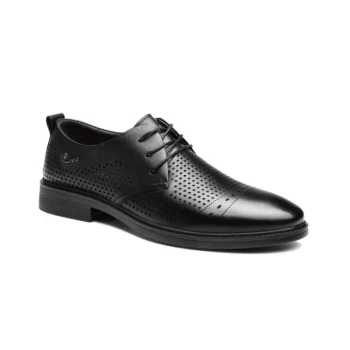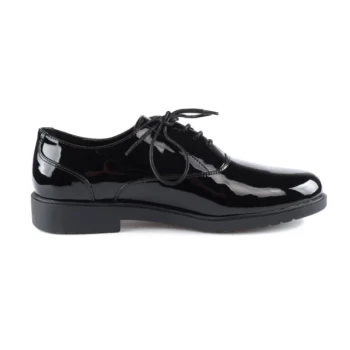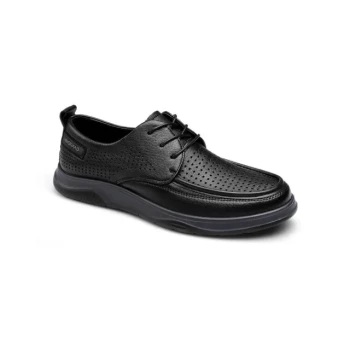To wear high heels safely, you must focus on three core precautions: dramatically limiting the duration and frequency of wear, minimizing the distance you walk in them, and being highly selective about the shoe's design. The most effective strategies involve treating heels as short-duration footwear for special occasions and choosing designs with lower heights and wider toe boxes.
The fundamental issue with high heels is that they force your body into an unnatural alignment. The best precautions, therefore, are not about finding a "safe" high heel, but about intelligently managing your exposure to this biomechanical stress.
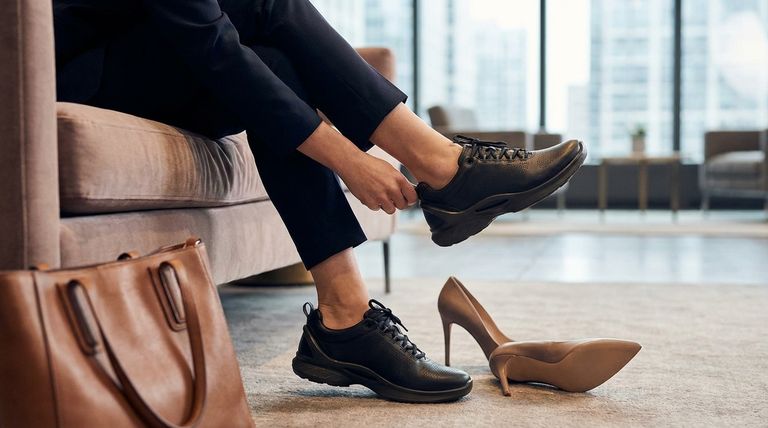
The Biomechanical Impact of High Heels
Understanding why precautions are necessary is the first step toward protecting your body. High heels are not passive accessories; they actively alter your posture and place significant strain on your musculoskeletal system.
Altered Body Alignment
Heels shift your center of mass forward, forcing your lower back to arch and placing unnatural pressure on the balls of your feet. This misalignment can lead to pain not just in your feet, but also in your knees, hips, and back.
Shortened Achilles Tendon
Wearing heels forces your foot into a downward-pointing position (plantarflexion). Over time, this can cause the Achilles tendon and calf muscles to shorten and tighten.
When you switch back to flat shoes or go barefoot, this shortened tendon is stretched, dramatically increasing your risk of an injury like Achilles tendonitis.
Weakened Foot and Ankle Structures
The unnatural position also leads to ankle instability and can weaken the muscles in your toes. The constant pressure and lack of natural movement contribute to a weaker, less resilient foot structure over the long term.
Proactive Strategies for Safer Wear
While the ideal scenario is to avoid heels, practical strategies can significantly reduce the associated risks when you do choose to wear them.
Limit Your Exposure
The most effective precaution is to reduce wear time. The American Podiatric Medical Association advises reserving high heels for special occasions only, not for daily use.
Minimize Walking Distance
Never treat high heels as walking shoes. Plan ahead to minimize the distance you have to cover in them.
Consider wearing comfortable walking shoes or flats to your destination and switching into your heels just before you arrive. Alternatively, park as close as possible or get dropped off directly at the entrance.
Choose a Smarter Heel Design
The design of the shoe itself plays a crucial role in the amount of stress it creates.
Prioritize a lower heel height. The most significant reduction in stress comes from choosing a heel that is two inches or lower.
Insist on a wider toe box. Pointy-toed shoes cram your toes into an unnatural, triangular shape. A shoe with a wide, accommodating toe box allows your toes to lie flat and reduces the risk of bunions and nerve pain.
Understanding the Trade-offs
Making an informed choice means acknowledging the inherent compromises of wearing high heels, even with precautions in place.
Even 'Comfortable' Heels Carry Risk
A well-designed, lower heel is certainly better, but it does not eliminate the fundamental problem. Any heel elevates your foot into an unnatural position, and no amount of padding can change that core biomechanical fact.
The Illusion of Stability
High wedges and platforms can feel more stable than stilettos, but they still present risks. Their rigid soles prevent your foot from flexing naturally as you walk, which can lead to its own set of strains on your feet and ankles.
Long-Term vs. Short-Term Effects
It's easy to focus on the short-term pain of a single evening. However, the real danger lies in the cumulative, long-term damage from repeated wear, such as chronic joint pain and tendon injuries.
Making the Right Choice for Your Goal
Your strategy should adapt based on your specific priority.
- If your primary focus is minimizing long-term damage: Reserve heels exclusively for brief, special occasions and always prioritize a heel height under two inches.
- If your primary focus is reducing pain during a specific event: Choose a heel with a wide toe box and use the "commuter shoe" strategy, only putting on your heels for the event itself.
Ultimately, protecting your body is about making conscious, informed decisions about your footwear.
Summary Table:
| Precaution | Key Action | Why It Matters |
|---|---|---|
| Limit Exposure | Wear only for special occasions, not daily. | Reduces cumulative stress on joints and tendons. |
| Minimize Walking | Switch to heels at the destination; avoid long walks. | Decreases immediate pressure on the balls of the feet. |
| Choose Smart Design | Opt for heels under 2 inches with a wide toe box. | Improves stability and reduces risk of bunions and nerve pain. |
Ready to prioritize both style and foot health? As a large-scale manufacturer, 3515 produces a comprehensive range of footwear for distributors, brand owners, and bulk clients. Our production capabilities encompass all types of shoes and boots, including designs that balance fashion with comfort and biomechanical safety. Let us help you provide footwear that your customers can wear with confidence. Contact our team today to discuss your manufacturing needs!
Visual Guide
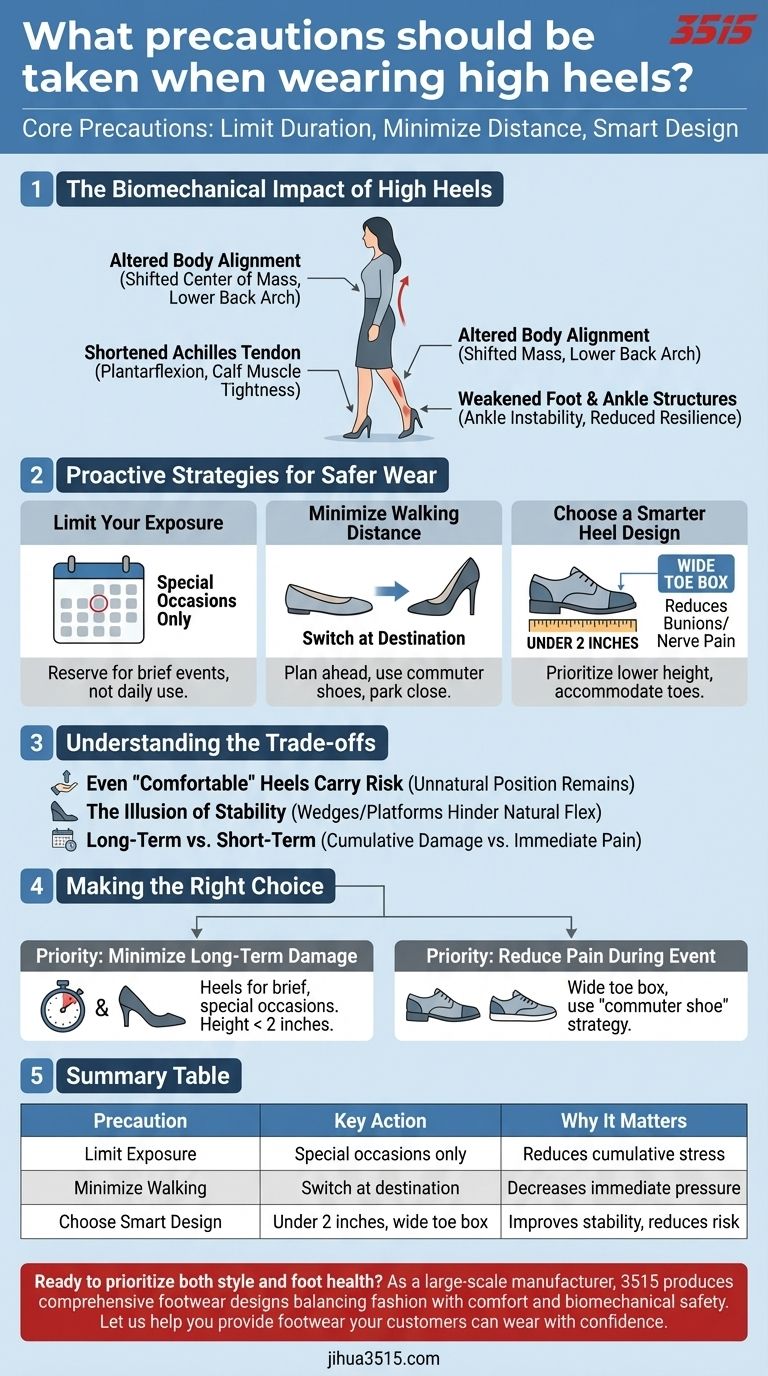
Related Products
- Wholesale Comfortable Business Casual Shoes Custom Manufacturing
- Custom Manufactured Air Cushion Leather Business Shoes for Wholesale
- Wholesale Durable & Breathable Training Shoes for Custom Brands
- Durable Rubber-Soled Utility Shoes for Wholesale & Custom Brand Manufacturing
- Wholesale Training Shoes with Dial Lacing System Custom OEM Manufacturing
People Also Ask
- What should someone do if they are unsure about a company's dress code? Navigate with Confidence
- What types of dress shoes are recommended for formal occasions? A Guide to Impeccable Style
- What is business casual shoes? Master the Perfect Blend of Professional Style and Comfort
- How can one balance a casual outfit when wearing dress shoes? Achieve a Polished Smart Casual Look
- What are the key considerations when choosing dress shoes for formal occasions? A Guide to Style, Color & Quality













